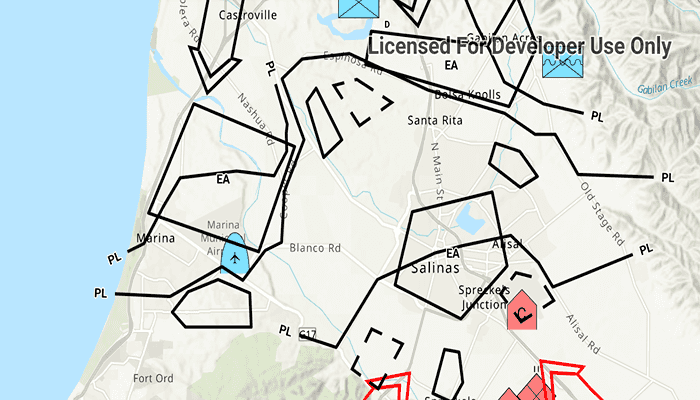Convert features into graphics to show them with mil2525d symbols.

Use case
A dictionary renderer uses a style file along with a rule engine to display advanced symbology. This is useful for displaying features using precise military symbology.
How to use the sample
Pan and zoom around the map. Observe the displayed military symbology on the map.
How it works
- Create a
Geodatabaseusingnew Geodatabase(geodatabasePath). - Load the geodatabase using
Geodatabase.load(). - Instantiate a
DictionarySymbolStyleusingDictionarySymbolStyle.createFromFile(dictionarySymbolStylePath). - Load the symbol dictionary using
dictionarySymbolStyle.load(). - For each
GeoDatabaseFeatureTablein theGeoDatabase, create a feature layer with it, then add it to the map usingmap.operationalLayers.add(featureLayer). - Create
DictionaryRenderer(dictionarySymbolStyle)and assign it to the feature layer renderer. - Set the viewpoint of the map view to the extent of the feature layer using
mapView.setViewpoint(Viewpoint(featureLayer.fullExtent)).
Relevant API
- DictionaryRenderer
- DictionarySymbolStyle
- FeatureLayer
- Geodatabase
About the data
The sample uses a mil2525d stylx file and a mobile geodatabase from ArcGIS Online.
Tags
military, symbol
Sample Code
/* Copyright 2023 Esri
*
* Licensed under the Apache License, Version 2.0 (the "License");
* you may not use this file except in compliance with the License.
* You may obtain a copy of the License at
*
* http://www.apache.org/licenses/LICENSE-2.0
*
* Unless required by applicable law or agreed to in writing, software
* distributed under the License is distributed on an "AS IS" BASIS,
* WITHOUT WARRANTIES OR CONDITIONS OF ANY KIND, either express or implied.
* See the License for the specific language governing permissions and
* limitations under the License.
*
*/
package com.esri.arcgismaps.sample.applydictionaryrenderertofeaturelayer
import android.os.Bundle
import android.util.Log
import androidx.appcompat.app.AppCompatActivity
import androidx.databinding.DataBindingUtil
import androidx.lifecycle.lifecycleScope
import com.arcgismaps.ApiKey
import com.arcgismaps.ArcGISEnvironment
import com.arcgismaps.data.Geodatabase
import com.arcgismaps.mapping.ArcGISMap
import com.arcgismaps.mapping.BasemapStyle
import com.arcgismaps.mapping.Viewpoint
import com.arcgismaps.mapping.layers.FeatureLayer
import com.arcgismaps.mapping.symbology.DictionaryRenderer
import com.arcgismaps.mapping.symbology.DictionarySymbolStyle
import com.esri.arcgismaps.sample.applydictionaryrenderertofeaturelayer.databinding.ApplyDictionaryRendererToFeatureLayerActivityMainBinding
import com.google.android.material.snackbar.Snackbar
import kotlinx.coroutines.launch
import java.io.File
class MainActivity : AppCompatActivity() {
// set up data binding for the activity
private val activityMainBinding: ApplyDictionaryRendererToFeatureLayerActivityMainBinding by lazy {
DataBindingUtil.setContentView(this, R.layout.apply_dictionary_renderer_to_feature_layer_activity_main)
}
private val mapView by lazy {
activityMainBinding.mapView
}
private val provisionPath: String by lazy {
getExternalFilesDir(null)?.path.toString() + File.separator + getString(R.string.apply_dictionary_renderer_to_feature_layer_app_name)
}
override fun onCreate(savedInstanceState: Bundle?) {
super.onCreate(savedInstanceState)
// authentication with an API key or named user is
// required to access basemaps and other location services
ArcGISEnvironment.apiKey = ApiKey.create(BuildConfig.ACCESS_TOKEN)
lifecycle.addObserver(mapView)
// create and add a map with a navigation night basemap style
val map = ArcGISMap(BasemapStyle.ArcGISTopographic)
mapView.map = map
// locate the .stylx file in the device
val styleFile = File(provisionPath, getString(R.string.mil2525d_stylx))
// instantiate the dictionarySymbolStyle using the file path
val dictionarySymbolStyle = DictionarySymbolStyle.createFromFile(styleFile.absolutePath)
// locate the .geodatabase file in the device
val geodatabaseFile = File(provisionPath, getString(R.string.militaryoverlay_geodatabase))
// instantiate the geodatabase with the file path
val geodatabase = Geodatabase(geodatabaseFile.path)
lifecycleScope.launch {
// load the dictionary symbol style
dictionarySymbolStyle.load().getOrElse {
return@launch showError("Error loading DictionarySymbolStyle: ${it.message}")
}
// load the geodatabase
geodatabase.load().getOrElse {
showError("Error loading Geodatabase: ${it.message}")
}
geodatabase.featureTables.forEach { geodatabaseFeatureTable ->
// load each geodatabaseFeatureTable and create featureLayer from it
geodatabaseFeatureTable.load().getOrElse {
return@launch showError("Error loading GeodatabaseFeatureTable: ${it.message}")
}
val featureLayer = FeatureLayer.createWithFeatureTable(geodatabaseFeatureTable)
featureLayer.load().getOrElse {
return@launch showError("Error loading FeatureLayer: ${it.message}")
}
// add featureLayer to the map's operational layer
mapView.map?.operationalLayers?.add(featureLayer)
// create dictionaryRenderer using the dictionarySymbolStyle and apply it to the featureLayer's renderer
val dictionaryRenderer = DictionaryRenderer(dictionarySymbolStyle)
featureLayer.renderer = dictionaryRenderer
// get the featureLayer's envelope to set the map viewpoint
val extent = featureLayer.fullExtent
?: return@launch showError("Error retrieving extent of the feature layer")
mapView.setViewpoint(Viewpoint(extent))
}
}
}
private fun showError(message: String) {
Log.e(localClassName, message)
Snackbar.make(mapView, message, Snackbar.LENGTH_SHORT).show()
}
}